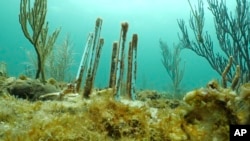Researchers in South Florida trying to stop predatory fish from devouring lab-grown coral are grabbing biodegradable straws in an effort to restore what some are calling an ocean rainforest.
Scientists around the world have been grappling with the problem of declining coral reef populations for years. Just last summer, coral reef rescue groups in South Florida and the Florida Keys were trying to save corals from rising ocean temperatures. In addition to working to keep existing corals alive, researchers are also growing new corals in the lab and then releasing them into the ocean.
But protecting underwater ecosystems, which account for more than 25% of all marine species, is not easy. Even more challenging is ensuring that coral grown in the lab and released into the ocean does not become expensive fish food.
One problem, said marine researcher Kyle Pisano, is that predators such as parrot fish try to bite and damage newly transplanted corals in areas like South Florida, resulting in survival rates of less than 40 percent. As the project calls for planting thousands of corals over the next year and tens of thousands more over the next decade, losses add up when each piece of coral costs more than $100.
Pisano and his partner Kirk Dotson developed Coral Castles, claiming that small biodegradable cages made partly from straw can increase the survival rate of transplanted corals to more than 90 percent.
“Parrot fish on coral reefs really like to bite newly transplanted coral,” Pisano said. “They treat it like popcorn.”
Fortunately, fish eventually lose interest in the coral as it matures, but scientists need to protect the coral in the meantime. In the past, stainless steel and PVC pipe barriers were placed around transplanted corals, but these barriers required clearing of algae growth and eventual removal.
Pisano’s idea was to create a protective barrier that would eventually dissolve, eliminating the need to maintain or remove it. As part of his master’s degree program at Nova Southeastern University, he began conducting at-sea experiments using biodegradable coral cages. He used something called polyhydroxyalkanoate, a biopolymer derived from the fermentation of canola oil. PHA biodegrades in the ocean, leaving only water and carbon dioxide. His findings were published last year.
The coral cage consists of a limestone disk surrounded by eight vertical phade brand straws and was manufactured by WinCup Inc. in Atlanta. The device doesn’t have a top, Pisano said, because juvenile corals need sunlight and parrot fish don’t generally want to eat face down.
Dotson, a retired aerospace engineer, met Pisano through a professor at Nova Southeastern University, and the two formed Reef Fortify Inc. to further develop and market the patent-pending Coral Fortify. The first cages will sell for $12 each, but Pisano and Dotson believe that may change as production scales up.
Early prototypes of cages made from Feder’s standard straws were able to protect corals for about two months before dissolving in the ocean, but that wasn’t enough to interest the parrot fish. When Pisano and Dotson approached phade for help, the company assured them that it could create almost any custom shape out of its biodegradable PHA material.
“But it turns out that boba straws work great right out of the box,” Dotson said.
Boba straws are wider and thicker than regular straws. They are used for tea drinks and have tapioca balls at the bottom of the cup. For Pisano and Dotson, the extra thickness means the straws last long enough to protect growing corals before disappearing harmlessly.
Reef Fortify hopes to work with coral reef restoration projects around the world. Coral Castle has been used by researchers at Nova Southeastern University, the University of Miami, and the Hawaii Department of Aquatic Resources.
Rich Karp, a coral researcher at the University of Miami, said they have been using Coral Castle for about a month. He points out that doing any work underwater takes a lot of time and effort, so having a protective cage that dissolves when no longer needed can essentially cut their workload in half.
“Simply putting the coral in a cage and then removing the cage is twice the work, twice the time on the bottom,” Karp said. “And it’s not really scalable.”
Experts say coral reefs are an important part of the marine ecosystem. They occupy less than 1% of the global ocean area, but provide food and shelter for nearly 25% of marine life. Coral reefs also help protect people and their homes in coastal areas from the effects of storm surges during hurricanes.
Follow us on Google news ,Twitter , and Join Whatsapp Group of thelocalreport.in

















